Horse Girths & Cinches: Types,
Materials, & Selecting the Best
How to Choose the Best Girth or Cinch for Your Horse
A girth or cinch is an essential piece in your tack collection; it aids in keeping the saddle secure on your horse while promoting their natural movement. To ensure maximum comfort and performance, and to help prevent galling, you'll need to decide which girth or cinch is best suited for your discipline and horse. As there are many factors to consider when choosing the right girth or cinch, our equine experts have created a comprehensive guide to help you more easily navigate the options available to you.
Before you begin the process of finding a new girth or cinch, we suggest starting with a well-fitting saddle, as the two work together harmoniously. You can collaborate with a professional saddle-fitter or trainer to find a saddle that fits both you and your horse. To learn about the different types of saddles and receive additional insight on common saddle fit concerns, we invite you to check out our comprehensive guide on how to measure a saddle.
Horse Girth & Cinch Types
First and foremost, it is important to know the differences between a girth and a cinch. Girths are used on English-style saddles, which include dressage, jumping, and all-purpose saddles; girths generally come with two buckles on either side to attach to the saddle's billets. Cinches are used on Western saddles and have a buckle on either end, one of which attaches to the off billet and the other that the latigo is secured through. Endurance saddles can be seen with either girth or cinch attachments.
English Girth Types
There are different types of English girths, depending on the saddle you ride in. Dressage saddles and monoflap jumping saddles generally have long billets that extend below the flap, requiring a short dressage girth commonly ranging between 18" to 32" in size. Other saddles, like the close-contact or all-purpose, have much shorter billets and require a longer English girth that typically ranges from 38" to 58" in size.
Western Cinch Types
Western cinches, or front cinches, are fairly standard in type but can differ in shape, material, and style of buckle. They are typically offered in 2" increments that range between 24" to 38" in size.
Endurance Girth/Cinch Types
Endurance girths and cinches are dependent upon the rigging of your saddle, as endurance riders can be seen riding in Western trail, English, endurance, or Australian type saddles. A girth is required if you have English-style billets; on the other hand, Western-style rigging will need a cinch. Some Australian saddles require an Australian girth, like the Toklat WoolBack Australian Girth, to accommodate their unique rigging (depending on whether your Aussie saddle does or does not have an overgirth).
Horse Girth & Cinch Materials
Each material below can be found in a girth or cinch and serves a unique purpose in order to keep your horse comfortable when saddled. Which material best suits your horse will depend on the sensitivity of their skin, whether your saddle tends to slide, and your personal aesthetic preference.
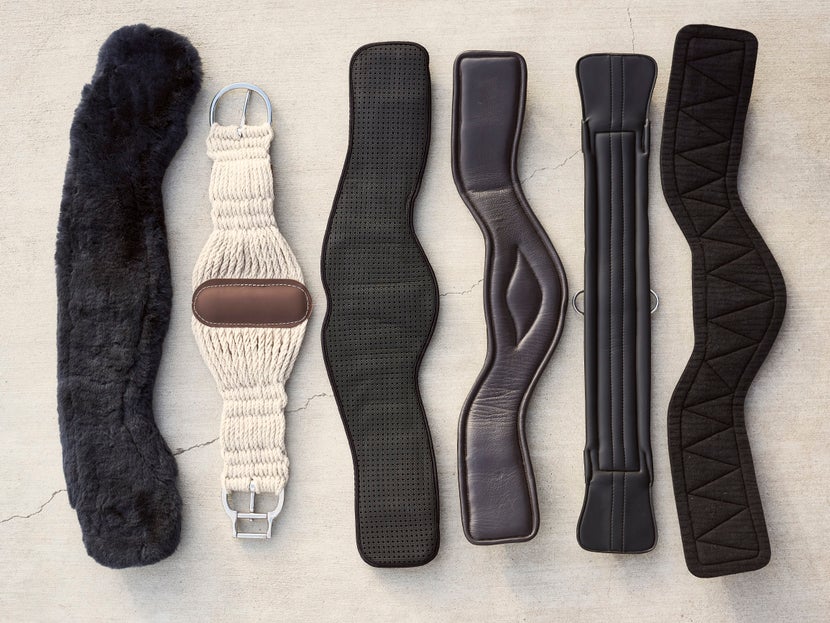
Cinch/Girth Materials From Left to Right: Fleece, Mohair, Neoprene, Leather, Foam, & Felt
Fleece: Fleece girths and cinches feature soft, natural fibers that allow for breathability and are great for sensitive horses. However, this material is likely to slip and therefore needs to be tightened closer to the horse's barrel to ensure a secure fit. This soft, dense material can be difficult to keep clean and should be cared for after each ride. If you find that your horse might need extra protection but a true fleece girth isn't for you, some brands sell fleece covers or liners to pair with their girths and cinches.
Mohair: Mohair is a traditional material that has been used for decades and is most commonly used in Western cinches. Also called a string girth, this material is strong, durable, extremely breathable, and quick drying. Some cinches feature double-layered mohair, which tends to be more durable than just a single layer.
Neoprene: Neoprene is a non-slip material that is easy to clean and manage. The strong grip may not be suited for sensitive horses, as neoprene can cause rubs and sores if over-tightened. If you have used a leather girth or cinch and experienced slipping, neoprene is a great second option to try for your horse. Some neoprene material has perforations to allow for added breathability. Additionally, neoprene girths are easy to care for!
Leather: Leather gives a traditional look and is easy to care for. Leather can start rigid but over time will soften and conform to the shape of your horse. Some leather girths and cinches even offer padding along the interior for comfort and to decrease pressure points. For those looking for a budget-friendly alternative to leather, synthetic materials from brands like Wintec are also durable and easy to clean.
Foam: Foam is a great alternative to neoprene. Grippy and easy to clean, foam offers similar benefits to neoprene but can be better for sensitive horses since it doesn't tend to hold as much heat. Some girths or cinches use memory foam, which adapts the shape of the individual horse's body for ultimate comfort.
Felt: A tried and true material, felt is typically only found in cinches. This versatile material is great in a multitude of climates as it is highly breathable, moisture-wicking, and distributes pressure evenly. As with fleece, it can be difficult to maintain and requires cleaning after each ride to prevent the buildup of hair, dirt, and sweat.
Horse Girth & Cinch Shapes
When choosing a girth or cinch style, it's important to consider the conformation of your horse's body. Does your horse have wide or narrow shoulders? How close is their girth groove to their elbows and how long is that groove? Do they have a wide barrel or are they more wedge shaped (wide in the shoulders tapering backward)? All of these considerations will help you find the ideal girth or cinch style for your horse's conformation. Unlike straight girths and cinches, shaped girths and cinches have a designated front and back that could irritate the horse if put on incorrectly.
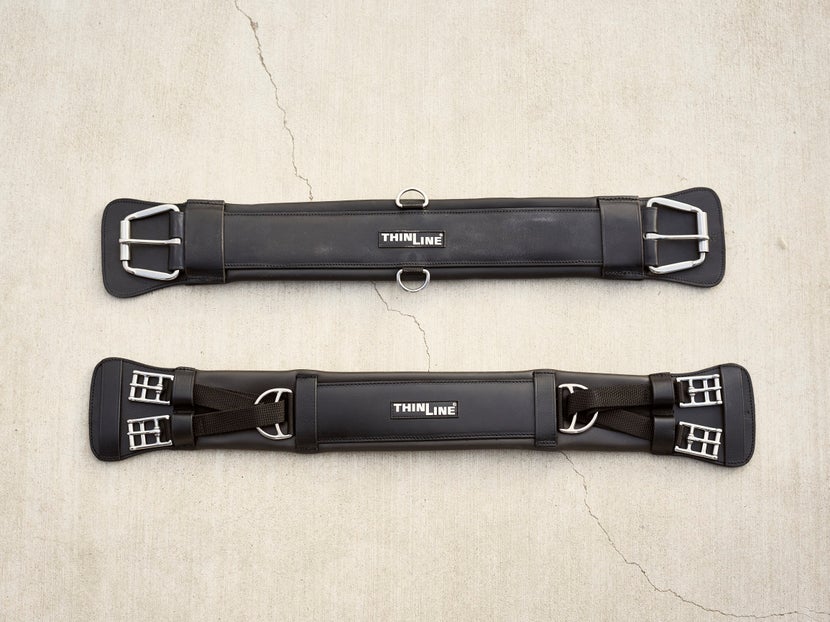
Pictured Above: Straight Cinch Top, Straight Girth Below
Straight: A straight girth or cinch has no curve to its shape and lacks contour around the horse's elbows. This shape is great if you are just starting out and aren't sure which girth or cinch to choose, or if you ride a variety of horses and want something simple to fit most. Straight girths are great for riders who are still learning about their tack since there is no front and back orientation.
Best for horses that have a proportional shoulder and barrel with a normal girth groove that isn't too close to their elbows.
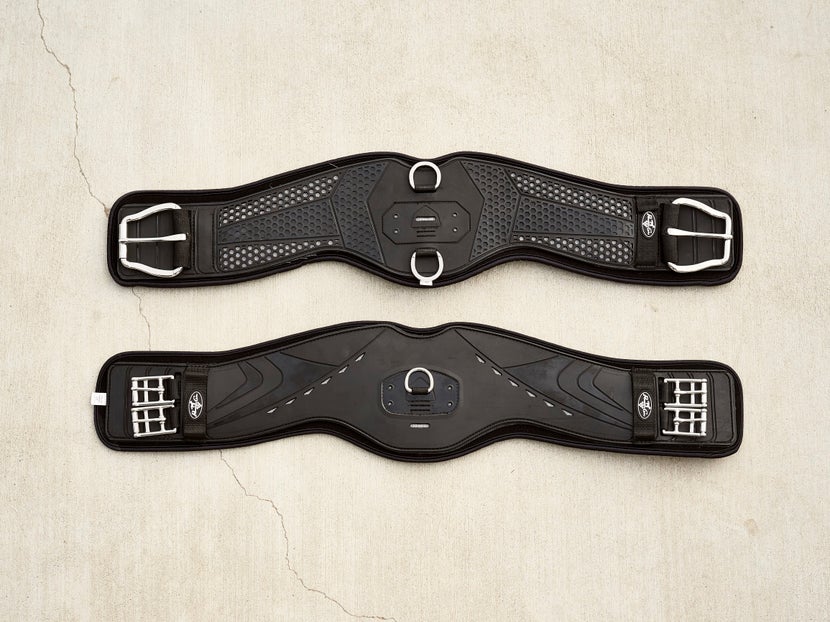
Pictured Above: Contoured Cinch Top, Contoured Girth Below
Contoured or Anatomic: Anatomic girths and cinches are shaped to help prevent chafing. On the front side, near the horse's armpits, the girth or cinch will have two cutbacks giving it a contoured look. The cutbacks allow your horse a wider range of motion and reduce the chance of rubs.
Best for horses that have a proportional shoulder and barrel but sometimes experience rubs behind their elbows.
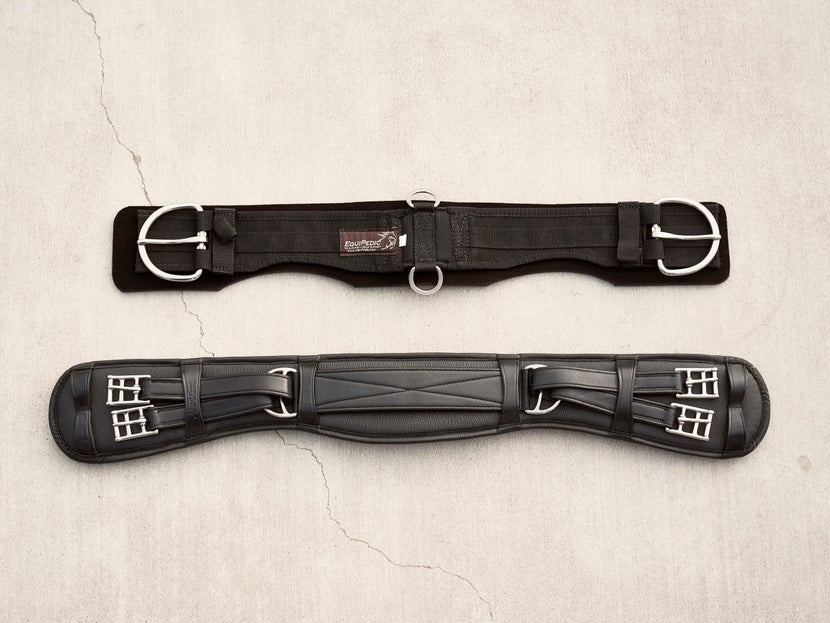
Pictured Above: Asymmetrical Cinch Top, Asymmetrical Girth Below
Asymmetrical: Asymmetrical girths or cinches have a contoured front side to give the horse's elbows space to avoid rubs and a straight backside for horses who may have a shorter girth groove or a groove that is close to their elbows. If you find that your girth or cinch tends to shift forward, an asymmetrical shape may help.
Best for horses with a short girth groove that lies close to their elbows.
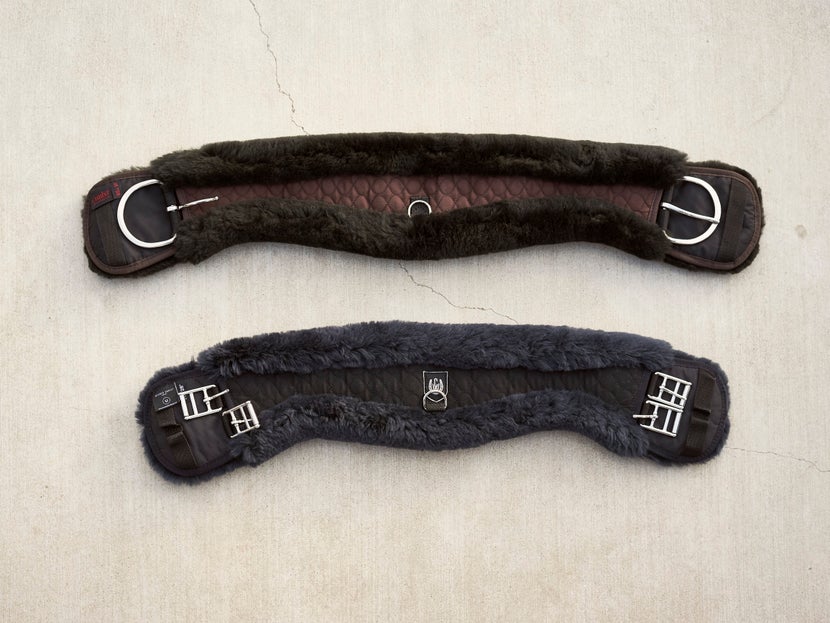
Pictured Above: Crescent Cinch Top, Crescent Girth Below
Crescent: Crescent-shaped girths or cinches stay out of the elbow area while giving horses with a wider ribcage plenty of room. If your horse has narrow shoulders and the saddle tends to slip forward, a crescent-shaped girth or cinch may help.
Best for horses who need room around their elbows and have narrow shoulders or a wide barrel.
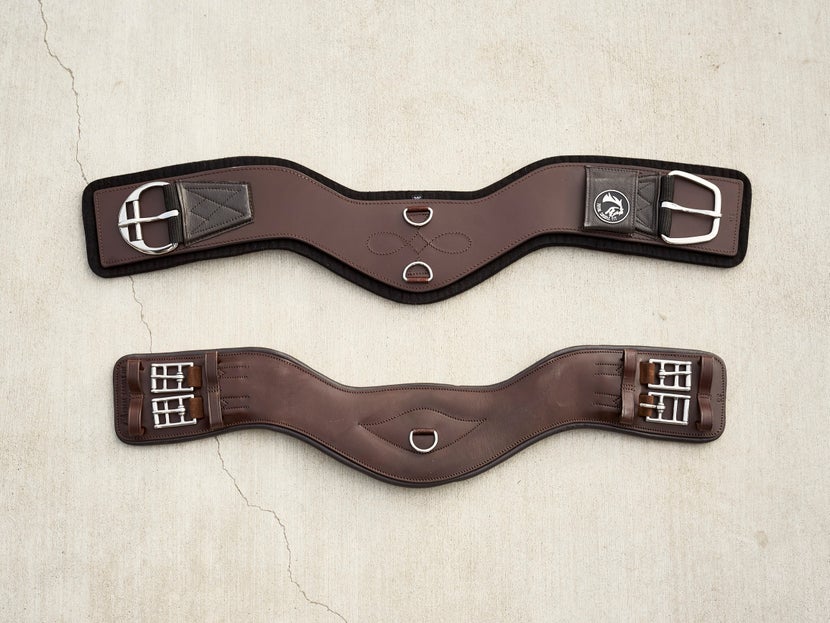
Pictured Above: Shoulder-Relief Cinch Top, Shoulder-Relief Girth Below
Shoulder-Relief: Shoulder-relief girths and cinches have the center set forward to sit in the horse's natural girth groove while the sides of the girth or cinch are cut back behind the horse's girth line. This reduces the saddle's tendency to be pulled into the shoulder, allowing the horse a full range of motion under saddle.
Best for horses that have wide shoulders, a short girth groove, and a wide barrel. Note that horses who have longer girth grooves or narrow barrels may experience slipping with these girths or cinches.
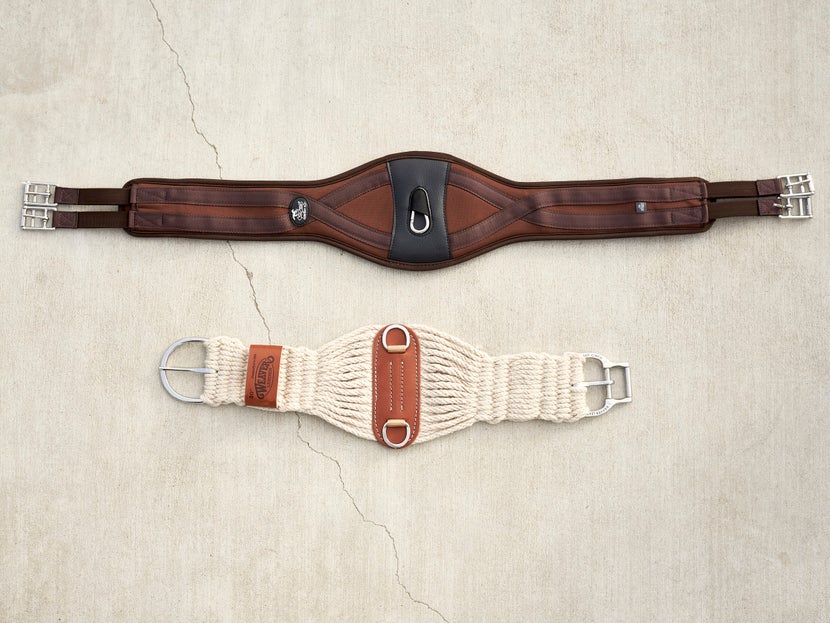
Pictured Above: Wide Center Girth Top, Wide Center Cinch Below
Wide Center: These types of girths and cinches widen through the middle to cover more surface area and offer a secure fit. When offered as a cinch, this shape is referred to as a "roper cinch" because it helps keep the saddle centered when handling cattle. This style can also be found in English girths and is an excellent choice for horses with low withers to keep the saddle from rolling side to side.
Best for horses with low withers that experience saddle rolling.
How to Measure for a Horse Girth or Cinch
There are many techniques for measuring your horse for a girth or cinch, and we suggest using whichever technique is easiest for you. Below, we've outlined one of the ways you can find the right girth or cinch size for your saddle and horse combination:
How to Measure for a Girth
To measure for a girth, grab a friend and a soft tape measurer with inch increments. First, place your saddle on the horse's back and have your friend hold the tape measure at approximately the middle billet hole on one side. Stretch the tape under the horse's barrel to the corresponding billet hole on the other side of the saddle. This will be your horse's "estimated size." For more information, you can watch our helpful how-to video on measuring for an English girth. Or, read our article on measuring and fitting a dressage girth!
How to Measure for a Cinch
To measure for a cinch, you will also need to grab a friend and soft tape measurer with inch increments. First, place your saddle on the horse's back and have your friend hold the tape measurer at the D-ring on one side of the saddle. Stretch the tape under the horse's barrel to the D-ring on the opposite side. Once you have this measurement, subtract 16" from of your total. This will allow you to have 8" of space between the saddle D-rings and cinch buckle on both sides. Maintaining this space helps prevent having too much leather underneath your legs while riding. For more information, you can watch our helpful video covering how to measure your horse for a cinch.
Horse Girth & Cinch Accessories
Back Cinch: For Western saddles, a back cinch can be added to relieve pressure on the withers by keeping the saddle level and preventing it from shifting forward. The back cinch, otherwise known as a rear cinch, is attached to the front cinch with a leather hobble strap on the bottom of the barrel. This small strap plays an important role when using a back cinch, as it prevents the back cinch from slipping toward the horse's flank.
Overgirth: In the case of an Australian girth, there is a specific Australian saddle rigging that requires an overgirth strap. If your Australian saddle has two billets on one side, and a ring and one billet on the other, an Aussie girth with an overgirth strap is used to thread the strap through the ring before buckling it. An overgirth strap allows for extra security on the trail in case one of your billets breaks. The overgirth is not necessary if your Australian saddle has standard English rigging, or a surcingle-type rigging.
Dee-Rings: Many girths and cinches come with dee-rings in the center to connect your breastplate or breast collar. Cinches usually also come with a backward-facing dee-ring so you can connect the cinch hobble for a back cinch. If you purchase a girth or cinch without these dee-rings and need to connect a breastplate or breast collar, you can use a girth loop.
Girth & Cinch Converters: Converters are small tack pieces that attach to the end of your girth or cinch and can convert your cinch to a girth or convert your girth to a cinch.
Girth Extenders: A girth extender, like the Camelot Leather Girth Extender, allows you to make your girth longer in case your horse gains a few extra pounds during time off! These are only for English-style girths, since they are designed to attach to two billets.
Horse Girth & Cinch Care
Girths and cinches require regular maintenance to remove built-up hair, dirt, and sweat that could irritate your horse's skin. Care will depend upon the material, as a fleece girth or cinch will require a different cleaning method than a leather one. Below are general instructions on how to clean the different girth and cinch materials in order to lengthen their lifespan. However, note that some manufacturers do have specific instructions; it is always a good idea to double-check the manufacturer's directions prior to cleaning!
Wool & Fleece: Can be washed in a washing machine or by hand. Brush any hair or dirt off before washing. Use a special sheepskin/fleece laundry wash to prevent damage to the material. Let air dry and brush to re-fluff the fleece when dry.
Mohair: Hand-wash with mild soap and water. Rinse thoroughly and air dry.
Neoprene: Spray with a hose and let air dry.
Leather: Wipe off any hair or dirt with a wet rag or sponge and use a leather cleaner to thoroughly clean the girth or cinch. Let air dry. A leather conditioner can be used if desired once the leather is dry.
Foam: Like neoprene, spray with a hose and let air dry.
Felt: Loosen dirt and dried sweat with a curry comb. Shake out the cinch or vacuum to remove dirt. Using a hose, start at the center and move outward, making sure you spray at an angle. Use a neutral or alkaline-based shampoo, such as Woolite. Rinse the soap completely, as residue could irritate your horse's skin. Let air dry.
Frequently Asked Questions
Q: What is a horse girth? What is a horse cinch?
A: A girth or cinch is the belt that keeps a saddle in place. It goes underneath the horse's barrel, or belly, close to their shoulders to keep the saddle from shifting side to side. It's important to have a properly sized girth or cinch that can be tightened just enough to keep the saddle secure. A girth or cinch that is too small could cause uncomfortable pressure on your horse's sensitive nerves. A girth or cinch that is too big will make the saddle move around too much, which is unsafe for both you and your horse!
Q: Which girth or cinch is the best?
A: Determining which cinch or girth is the best is specific to you, the horse, the saddle, and your personal preferences. Like how the shape and material of clothes will feel different to different people, the same goes for horses! Trying out different girths or cinches is a great way to see what you and your horse prefer. Depending on the saddle, a certain girth or cinch will be more secure and comfortable than others. It does take some trial and error!
Q: What is the difference between a horse girth and cinch?
A: Cinches are used on Western-style saddles that use an off-billet and latigo. Girths are used on English-style saddles, or those with multiple narrow billets. You will sometimes see English saddles with three billet strap options when a girth only has two buckles; this is strategically designed to give you a backup billet if one breaks, or to put the girth in a more forward or back position. On Western saddles, there are sometimes multiple rigging placements to shift the cinch position and pressure distribution within the saddle.
Q: Do all girths work with all English saddles? Do all cinches work with all Western saddles?
A: No. The girth or cinch you need is dependent upon a variety of factors we've addressed in this article, like type, shape, and saddle style. However, you should also consider the size of the buckles on your girth or the width of the cinch rings that attach to the off-billet and latigo. If your billets or latigo are wider than the buckles or rings, you're going to have a tricky time tacking up your horse. It is always a smart idea to check for these measurements before you commit to purchasing a girth or cinch.
Closing Thoughts
Finding the right girth or cinch can be a challenge; however, evaluating your and your horse's needs is a good place to start! Begin with a saddle that fits well, then pair it with an appropriately-sized girth or cinch with a shape that is right for their conformation. Consider a material that suits your riding needs and addresses your horse's level of sensitivity. We hope this guide has made you feel more knowledgeable about girths and cinches. If you have any further questions, you can always contact our helpful customer service at info@ridingwarehouse.com or at 1(800)620-9145. Ride on!